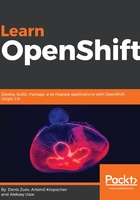
Kubernetes Overview
In the previous chapter, we discussed container architecture, worked with Docker images and containers, took a look at different Docker registries, learned how to manage persistent storage for containers, and finally, learned how to build our own Docker image with Dockerfile. All these skills will be required in Chapter 3, CRI-O Overview, where we start working with Kubernetes. Kubernetes is an essential and critical OpenShift component. It all works like a snowball: Docker skills are required by Kubernetes, and Kubernetes skills are required by OpenShift.
Container management in a distributed environment is difficult, but not with Kubernetes. This brief introduction to Kubernetes will give you an idea of what Kubernetes is and how it works. In this chapter, you will learn how to install and configure a Kubernetes cluster using a simplified method. We will also explain the container management basics, including some theories regarding pods, services, and routes. We will show you how to deploy an application in a Kubernetes cluster.
In this chapter, we will look at the following:
- Container management systems overview
- The difference between Kubernetes and Docker Swarm
- Kubernetes key concepts
- Kubernetes installation and configuration
- Working with kubectl
- Clearing the virtual environment
- Kubernetes limitations